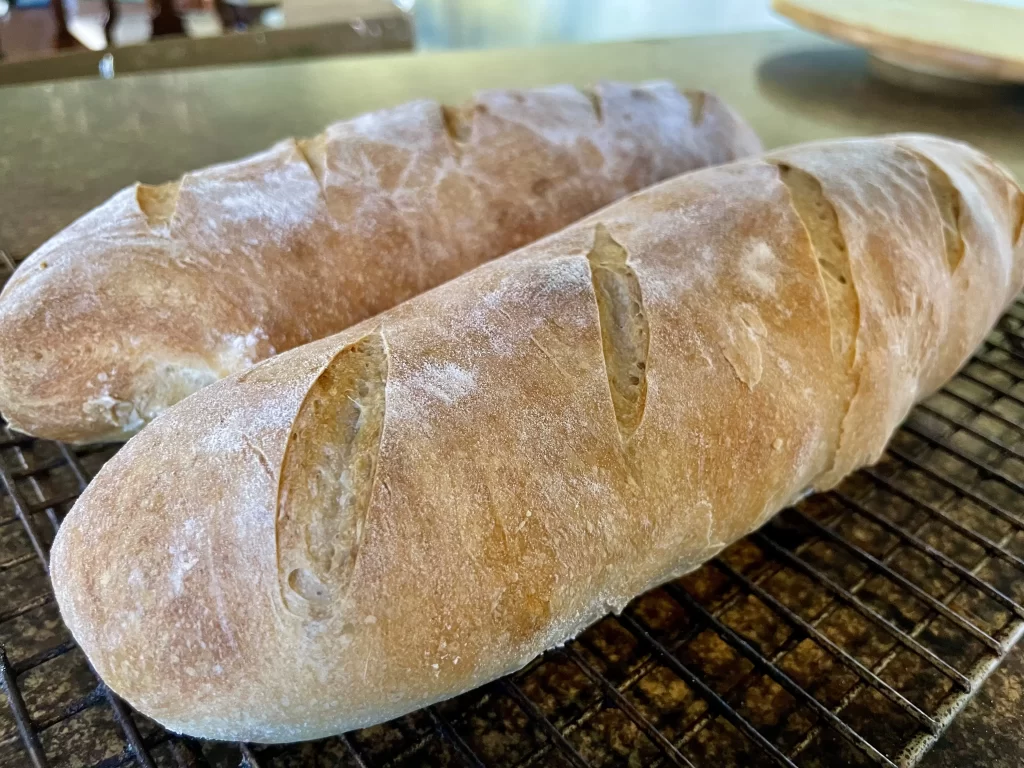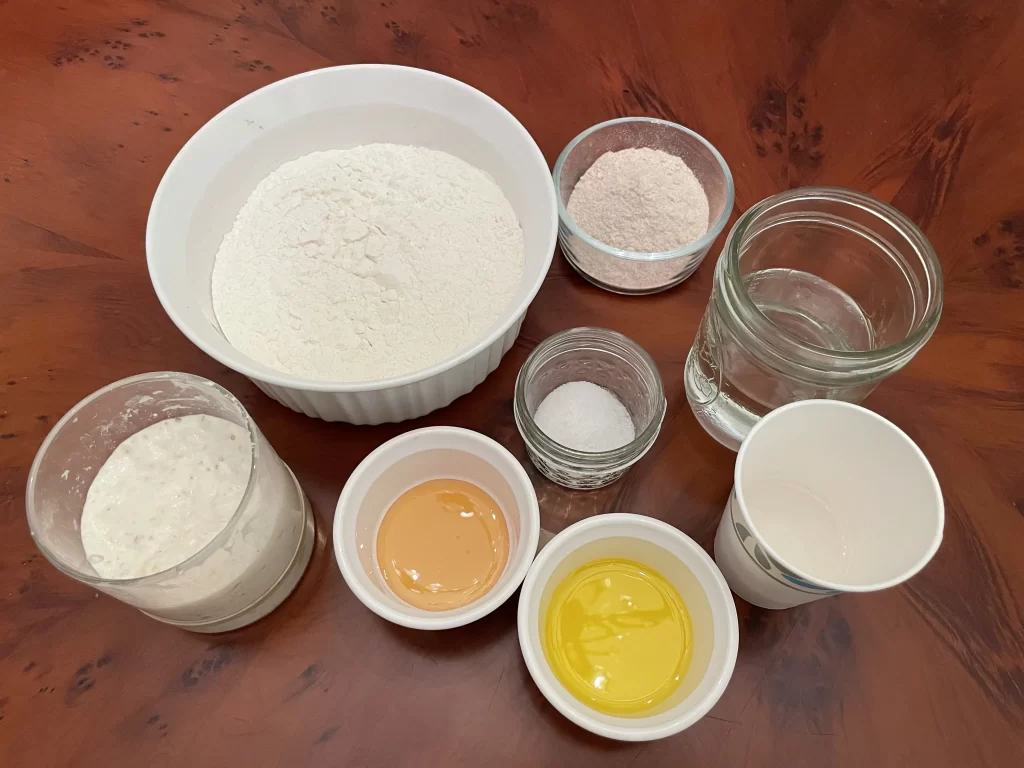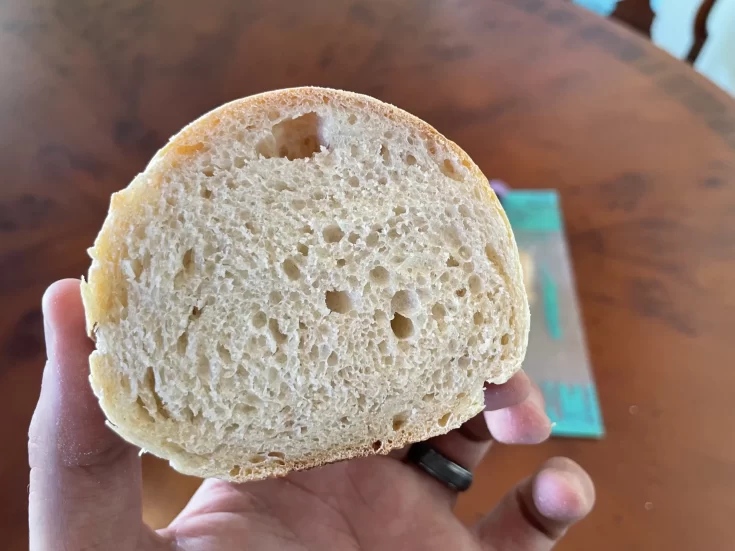This sourdough French bread recipe makes two long, soft and fluffy loaves of bread that are perfect for making sub sandwiches, garlic bread, or French bread pizza. This type of bread likely originated in Louisiana and is the main bread used to make po’ boy sandwiches.

Ingredients You’ll Need

- Bread Flour: I used King Arthur bread flour.
- Whole Wheat Flour: I used Bob’s Red Mill whole wheat flour.
- Water: Use bottled spring water or unchlorinated tap water.
- Milk: Any type of milk will work. See below for milk alternatives.
- Sourdough Starter: Any regular 100% hydration sourdough starter will work for this recipe.
- Olive Oil: Extra virgin olive oil or regular olive oil will work.
- Honey: I used a local honey from my area, but regular store-bought honey works the same in this recipe. See below for honey alternatives.
- Salt: I used Kosher salt but sea salt and plain table salt work just fine.
Note: Check recipe card below for full ingredient amounts and quantities.
Substitutions and Additions
- Using White Sugar instead of Honey: If desired, you could use an equal weight of white sugar in place of the honey.
- Using a Milk Alternative: You can use a non-dairy milk alternative of your choice, or replace the milk with water. This will not greatly affect the recipe. However, I would stay away from coconut milk or other strongly flavored milks that would add a distinct flavor to the bread.
- Use Another Fat instead of Olive Oil: For this recipe, you can use an equal weight of melted butter or a neutral oil, like canola oil.
Ingredient Amounts
Sourdough Starter Feeding
- Sourdough Starter, leftover – 25 grams
- Bread Flour – 50 grams
- Water – 50 grams
Main Dough
- Bread Flour – 400 grams
- Whole Wheat Flour – 50 grams
- Water – 300 grams
- Sourdough Starter, active – 100 grams
- Milk – 50 grams
- Olive Oil – 14 grams
- Honey – 14 grams
- Salt – 10 grams
How to Make Sourdough French Bread
Step-by-Step Instructions
Feeding the Starter
- The night before you want to bake, take 25 grams of leftover sourdough starter out of the fridge and feed it 50 grams of water and 50 grams of flour. Mix together thoroughly, mark the top of the starter with a rubber band, and set it on the counter. Let it rise overnight for 8-12 hours. The next morning the starter should have doubled in size.
Mixing the Dough
- In the morning, begin mixing all of the dough ingredients into the same mixing bowl, adding the flour last. Mix water, milk, honey, olive oil, starter, and salt together until well combined. Then, add the bread flour and whole wheat flour. Mix until a shaggy dough is formed.
- Cover up the bowl of dough with a kitchen towel and let it rest for 30 minutes.
The First Rise (Bulk Fermentation)
- Next, perform a set of stretch and folds. Stretch an edge of the dough up into the air and fold it over the top of the dough. Turn the bowl and grab another edge of the dough and do the same. Repeat this process, stretching and folding until you feel the dough tighten and resist stretching. Then, cover the dough and let it rest for 30 more minutes.
- Perform two more sets of stretch and folds with 30 minutes of rest in between the sets.
- After the last set of stretch and folds, flip the dough over in the mixing bowl so that the smooth side is facing up. Cover the dough with a kitchen towel and let it rise at room temperature for 4-8 hours. This step is commonly called the first rise, or bulk fermentation.
Dividing and Shaping
- Once the dough has doubled in size, place the dough, sticky-side-up, on a floured counter. Stretch the dough out into a rectangle, and then divide the dough into two equal smaller rectangles with a bench scraper or knife.
- Roll each rectangle longways into a long, tube-shaped loaf. Place the shaped loaves onto a metal sheet pan lined with parchment paper.
The Final Proof
- Cover up the loaves with a kitchen towel and let the dough rise for 2-3 hours. This is the second rise, or the final proof.
- 30 minutes before you are ready to bake, preheat your oven to 450°F (232°C) and place a metal cake pan or pie pan onto the bottom rack of your oven. You will put boiling water into this hot pan later to add steam to the oven.
- When the dough is done proofing, it should have increased in volume and feel slightly puffy to the touch.
Scoring and Baking
- Score five diagonal lines into the top of each loaf with a razor blade, bread lame, or a serrated knife.
- Transfer the sheet pan of sourdough French bread into the middle rack of the oven and pour a cup of boiling water into the metal pan on the bottom rack. Steam will fill the oven and allow the bread to expand as it bakes, giving it a better crust.
- Let the bread bake for 15 minutes, then remove the pan of water. Bake for an additional 10 minutes, or until the bread has a brown color on the crust that you like.
Serving Sourdough French Bread
- Let the bread cool on a wire rack for 20-30 minutes before slicing into the bread.
- Serve slices with olive oil or butter, turn the slices into garlic bread, or cut the sourdough French bread lengthwise to make sandwiches or French bread pizza. Enjoy!
Sourdough French Bread

This sourdough French bread recipe makes two long, soft and fluffy loaves of bread that are perfect for making sub sandwiches, garlic bread, or French bread pizza. This type of bread likely originated in Louisiana and is the main bread used to make po' boy sandwiches.
Ingredients
Sourdough Starter Feeding
- Sourdough Starter, leftover - 25 grams
- Bread Flour - 50 grams
- Water - 50 grams
Main Dough
- Bread Flour - 400 grams
- Whole Wheat Flour - 50 grams
- Water - 300 grams
- Sourdough Starter, active - 100 grams
- Milk - 50 grams
- Olive Oil - 14 grams
- Honey - 14 grams
- Salt - 10 grams
Instructions
- The night before you want to bake, take 25 grams of leftover sourdough starter out of the fridge and feed it 50 grams of water and 50 grams of flour. Mix together thoroughly, mark the top of the starter with a rubber band, and set it on the counter. Let it rise overnight for 8-12 hours. The next morning the starter should have doubled in size.
- In the morning, begin mixing all of the dough ingredients into the same mixing bowl, adding the flour last. Mix water, milk, honey, olive oil, starter, and salt together until well combined. Then, add the bread flour and whole wheat flour. Mix until a shaggy dough is formed.
- Cover up the bowl of dough with a kitchen towel and let it rest for 30 minutes.
- Next, perform a set of stretch and folds. Stretch an edge of the dough up into the air and fold it over the top of the dough. Turn the bowl and grab another edge of the dough and do the same. Repeat this process, stretching and folding until you feel the dough tighten and resist stretching. Then, cover the dough and let it rest for 30 more minutes.
- Perform two more sets of stretch and folds with 30 minutes of rest in between the sets.
- After the last set of stretch and folds, flip the dough over in the mixing bowl so that the smooth side is facing up. Cover the dough with a kitchen towel and let it rise at room temperature for 4-8 hours. This step is commonly called the first rise, or bulk fermentation.
- Once the dough has doubled in size, place the dough, sticky-side-up, on a floured counter. Stretch the dough out into a rectangle, and then divide the dough into two equal smaller rectangles with a bench scraper or knife.
- Roll each rectangle longways into a long, tube-shaped loaf. Place the shaped loaves onto a metal sheet pan lined with parchment paper.
- Cover up the loaves with a kitchen towel and let the dough rise for 2-3 hours. This is the second rise, or the final proof.
- 30 minutes before you are ready to bake, preheat your oven to 450°F (232°C) and place a metal cake pan or pie pan onto the bottom rack of your oven. You will put boiling water into this hot pan later to add steam to the oven.
- When the dough is done proofing, it should have increased in volume and feel slightly puffy to the touch.
- Score five diagonal lines into the top of each loaf with a razor blade, bread lame, or a serrated knife.
- Transfer the sheet pan of sourdough French bread into the middle rack of the oven and pour a cup of boiling water into the metal pan on the bottom rack. Steam will fill the oven and allow the bread to expand as it bakes, giving it a better crust.
- Let the bread bake for 15 minutes, then remove the pan of water. Bake for an additional 10 minutes, or until the bread has a brown color on the crust that you like.
- Let the bread cool on a wire rack for 20-30 minutes before slicing into the bread.
- Serve slices with olive oil or butter, turn the slices into garlic bread, or cut the sourdough French bread lengthwise to make sandwiches or French bread pizza. Enjoy!
